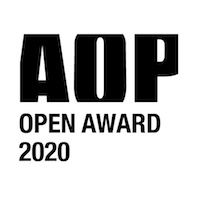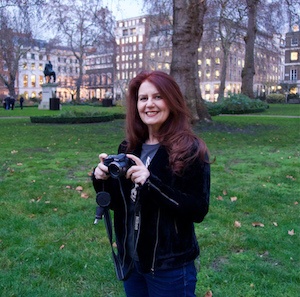News
INTERVIEW: Anne Mannion, Open Award Curator
2 March 2020

Working as a lawyer at Swan Turton, the leading law lawyers in the country for photographers, Anne Mannion has a long standing relationship with photographers. As a keen photography collector Anne has a long standing relationship with photography. We sat down with Anne to find out which photographers inspire her and importantly what she will be looking for amongst the entries for this years Open Award. Anne encourages innovative work, embracing the use of AI, AR, CGI etc.

© Catalina Blackman
What is your background?
I’ve had several careers, I have always worked in the media since I was 10 years old, which is a long time now! I started as an actor and did about 150 television commercials as a child. I did a television series for the BBC along with a couple of films including Bugsy Malone and I was in a couple of West End shows. After that I got stage fright and decided to go into producing, starting out as a theatre producer but then moved quite quickly into film. I went to the National Film and Television School and very quickly met a group of people who wanted to make commercials so we set up a television commercials company whilst we were at film school at the same time as making our short films. We were very successful for about 10 years at which point I made a feature film in New York, which I didn’t enjoy so much as it was very stressful!! It was at this point that I felt that I wanted a new career and a new life so I thought I would become a lawyer. I did a degree, which involved doing work experience alongside it. Because of my background in media I did work experience at Swan Turton and I’ve never left. I have been very fortunate to be mentored by Charles Swan who was a previous AOP Board Member, and he and I, along with Rupert Grey, who is another consultant at Swan Turton, are the leading photography law lawyers in the country.
Can you tell us about your involvement with the AOP?
I have worked with the AOP all the time that I have been at Swan Turton because Charles was on the board and we have been the AOP’s lawyers, so I have been advising AOP photographers for the last 10 years. When the opportunity came up on the board I jumped at it like a shot because this is a world that I really love and I hoped that I could make some sort of contribution. I joined the board in 2016 and in 2019 I was asked to be interim chair and after I had done that for a little while I was asked to be chair and I thought why not, what a wonderful opportunity. I am going to be here until 2022 so I really hope during the time I have left that I will be part of the change that is coming to the AOP. We have a new executive coming in with lots of new ideas and we are really thinking about how we can help photographers of the future.
Can you talk to us about your relationship with photography and which photographers inspire you?
I’ve had many years with photographers in my life, my brother is a photographer. I used to sit in his darkroom when I was about 12 when he was an assistant to a wonderful photographer called Pete Myers. We’re still friends with his son, Sean Myers, who is also a wonderful photographer. My brother Tom Mannion is now a leading interiors photographer, he works for the New York Times and World of Interiors. I then married a cinematographer, Stephen Blackman, at film school who made feature films and who became a leading car specialist for television commercials around the world. He has sadly passed away. It was so interesting for me to see the differences, as my brother Tom could make a film but it wasn’t quite the same way that Stephen would make one, but Stephen was useless at photography, all his photographs were taken documentary style and he would never pause long enough to make sure the person had the right smile. It was very curious to me that that was the way it was. So I really have observed the difference between the two types of disciplines and I do understand they are coming together now. I grew up watching those disciplines start to merge and also the transition from film to digital of course. I can absolutely smell the darkroom smells right now and going on to digital, the initial disappointment from everybody was like ‘Oh my god is this the quality now, is this what people will accept!’ But obviously we have moved on and the quality is amazing.
As the chair of the board and an independent board member, I keep up with developments in the photography world but I am not as knowledgeable as the professional board members. However, it really is a huge part of my life. I can look around all my walls and my house is full of photography, always has been. I have some terrific stories of my life where photographs have impacted. One is where I wanted to make a film of a book. I was chasing this author who really wasn’t paying much attention to me. When I finally met with him he said, ‘How do you see the character of Lily?’ and I said ‘Well, funnily enough I found this photograph in a magazine (I’d been carrying it around with me as I loved this picture) which to me is everything that Lily is.’ The image is of a girl dancing to jazz with her hair flying behind her by Robert Doisneau. The author couldn’t believe it, as he then showed me a photograph of his writing desk and above his desk was the same photograph which he had had in mind when he was writing the character. This is a great example of how photographs have helped me. So in the end I was able to buy that book and we developed it as a film project.
There are many photographers whose work I admire. I love Tim Flach’s work, I think he is such an inspiration, wow, to be changing the world through his photography like that. Bringing protection of the environment to the attention to the youngsters, (not that they need it, that generation are so much more awake than all of us), but Tim I think, is a big part of that. Making such wonderful images and again they tell a story that resonates.
In the same I way really love Nan Goldin who uses her photography to make political points such as bringing attention to the Oxycontin furore and how terrible it is that so many people have become addicted to that drug Highlighting the people that have made all the money out of the addiction and then funding the arts, it’s a very complex situation, but I love the fact that she has used her work and her position in the photography world to call the art galleries out on that. That said she has also made some beautiful fashion work, so it’s not all political.
I grew up with the work of David LaChapelle, all the Catholic iconic imagery and the drama of his work really resonates with me.
There were a few highlights for me from the AOP50 exhibition that I really loved. First, the image of Jimi ‘The Quiff’ by Amit & Naroop, if I had to have one on my wall it would be that one! I have also collected the work of Marcus Lyon for the past 20 years and it was wonderful to see his work in large scale at this exhibition also.
What would your uppermost advice be to photographers who may run into legal difficulties?
Get it in writing! Even if you are not going to negotiate a formal contract make sure that everything you say is backed up by emails. The problem we face as lawyers is, where is the evidence? This is what we are always looking for and ideally you would have a contract but so often that doesn’t happen, you might be working with friends and you don’t think its necessary until you run into problems. Even speaking between you and another person can be forming a contract, so if you agree to do something and they agree to pay you then just send a quick email saying, hi, following our conversation today we agreed to do this, you are going to pay me for this and the rights that I am granting you are these. But again, if you do run into difficulties just make sure that you send emails saying what the problems are and if you have a response from them that makes our lives so much easier to help you. Rather than just you telling me what they said because that is always open to interpretation, if you’ve got it in writing then we can use that in court!
As curator of the Open Awards what in your opinion makes for an Award winning image? What would your advice be those entering this category?
Something that tells a story, the images that speak to me are often those that have something that strikes my heart, in a way that I can look at it and it tells me a story. What was going on that day in that person’s life, by what they are wearing, by the colours in the room, the lighting etc. and I think the strongest images are those that resonate with us on a human level and life is about telling stories.
My advice to those entering the category would be don’t hold back, surprise us. I remember looking at last years Open Award finalists at the ‘Hate Heart’ innovation piece by Kai Bastard that was such fun and really exciting. As we look forward to the future there is going to be so much innovation with AR & AI etc. Lets try to step into that future so if anybody has anything like that, enter it and lets have a look, don’t hold back as we are really looking for something inspiring, something new.
You can find further information on the Open Awards here



